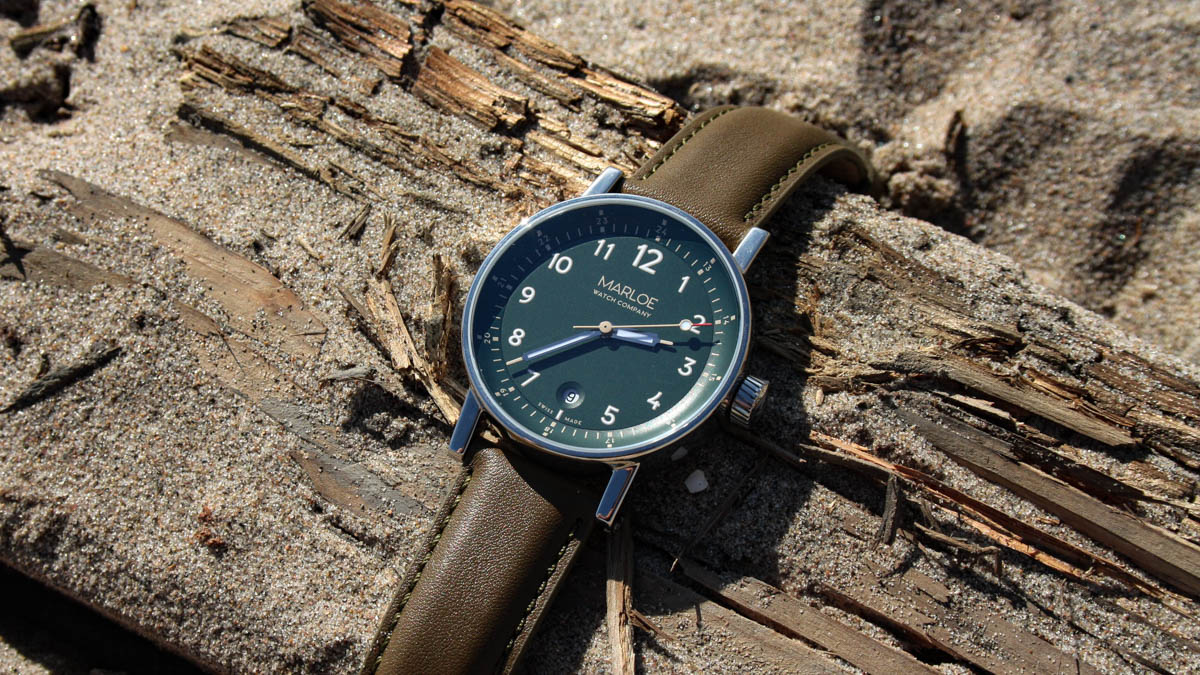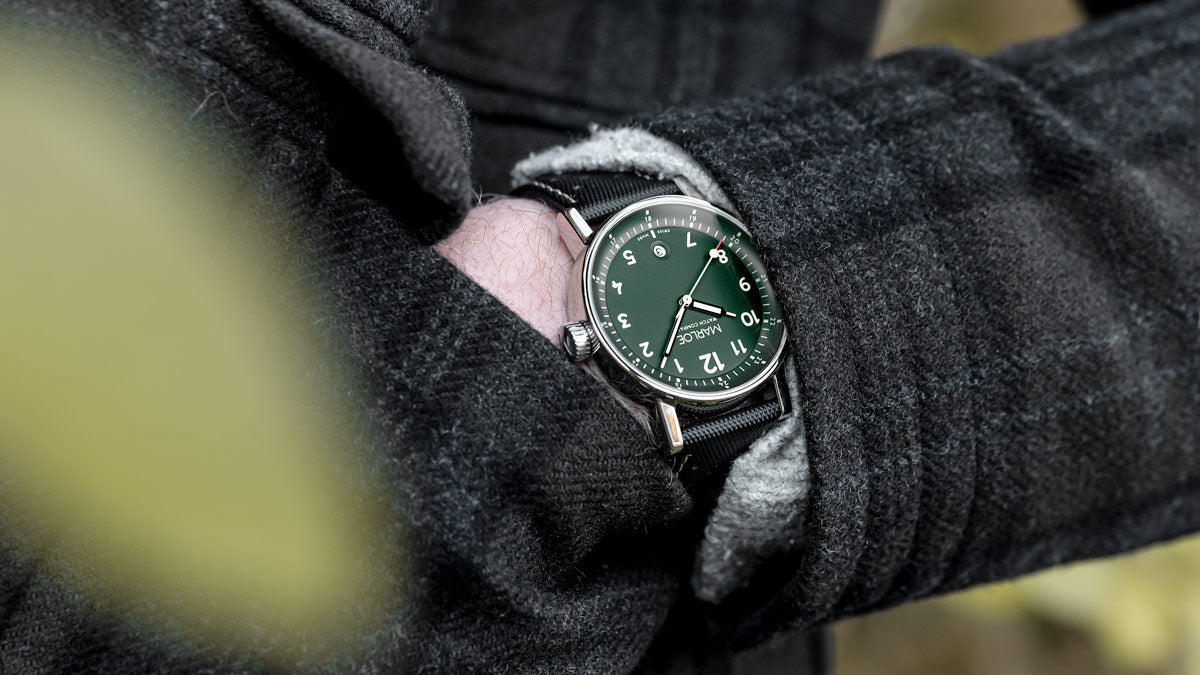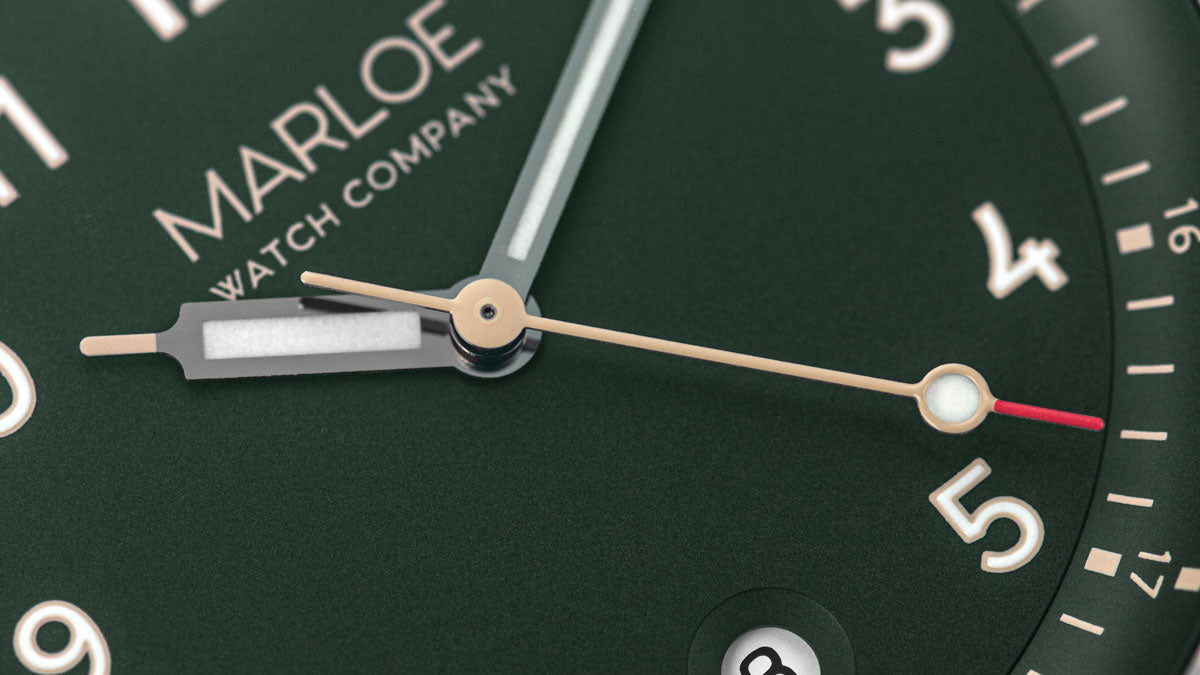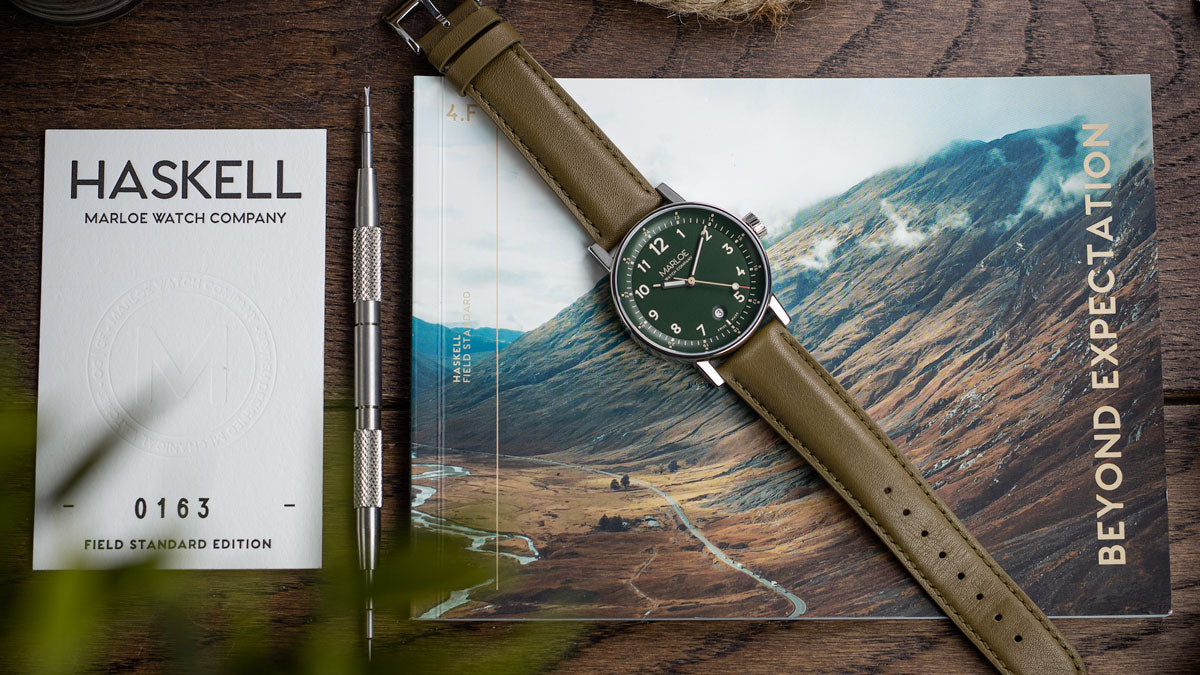The Marloe Haskell Field Standard: A watch designed to feel like it is from the earth, not a watchmaker bench...
As Britons, exploration is in our DNA. We have given the world some of its most famous explorers whose exploits still inspire us today. At weekends many of us enjoy strapping on a rucksack, packing a baseplate compass, and channelling our inner Shackleton. In the UK, we are spoiled for choice of places to explore on foot. From the craggy hills of the Peaks and Dales to the vast water vistas of the Lakes our country is easily accessible and beautiful.

The Marloe Haskell Field Standard - Image Credit: Richard Brown
The Marloe Haskell Field Standard - What It Does
The Marloe Haskell Field Standard is that quintessential watch. It looks like it has been grown from our earth rather than built in a factory and harks back to the design of classic old steel compasses which kept the early explorers on course.

The Marloe Haskell Field Standard on the Perforated Sailcloth Strap - Image Credit: WatchGecko Online Magazine
We first featured The Marloe Watch Company in March 2020 when we reviewed the striking Morar Diving Watch. Based in Perth, Scotland, the company states it is built upon honesty and integrity, which are fine values, and take their inspiration from stunning locations in the UK and around the globe. Marloe maintains that these values are at the heart of everything they do, and the results of such philosophy are the creation of beautiful watches powered by traditional mechanical movements. The Haskell portfolio could not be more different in design from that of the Morar, but it retains the similar theme of having a real background story to enhance the lore of the watch. Several subtly different models all take their name from the Haskell Ice Ridge, which is in the Darwin Mountains of Antarctica.
The watches set out to tell the story of Captain Robert Falcon Scott and his arduous trek to reach the South Pole. An infamous tale of bravery and effort against odds which proved to be impossible but typified the spirt of exploration. The colour palate of the Haskell range reflects the frozen region, from intense blues of the Antarctic ocean to the whites of the ice. All models have a beautifully engraved case back of either a map of the Antarctic or Ross Island where Scott’s journey began.

The Marloe Haskell Field Standard - Image Credit: WatchGecko Online Magazine
However, the Field Standard, which we had on test, is quite different which makes it the exception in the range. It is the only Haskell truly inspired by exploring Great Britain and its design faithfully reflects that. The uncluttered dial is forest green with sand writing which immediately creates the classic field watch look. The hands are purposeful with BGW9 blue Superluminova and have syringe pointers to replicate the look of an old compass. They have an unusual design element in that they can appear polished or black depending on the light which aids legibility.

The Marloe Haskell Field Standard - Image Credit: WatchGecko Online Magazine
The second hand has a red pointer which one could easily imagine showing the direction of travel. The numeral indices are also luminous and framed in a sandy outline or shadow, reminiscent of the tans and light browns of the winter mountains of Glencoe or some equally inaccessible place where you would need reliable kit to explore. The outer rehaut has the essential, serious traveller, 13-24 hour markers on an elegant curve which brings depth to the dial. This perception is further enhanced by a chamfered date window where the number 6 would be.

The Marloe Haskell Field Standard - Image Credit: WatchGecko Online Magazine
The Haskell range is all powered by a Sellita SW-215-1 manual winding mechanical movement with a date at the 6-indice. It is not a cumbersome movement measuring just 25.6mm in diameter, 3.35mm depth and giving a power reserve of 40 hours when fully wound. Beating at 28,800 bph; the second-hand moves around the dial at 8 beats per second which gives a satisfyingly smooth and effortless sweep. This light movement gives the watch, even with a steel case, a weight of just 78.3g. The Field Standard also has a unique case back which is a highly polished stylised compass design. Like the other models it has movement and depth rating (100m) and an individual serial number but no Antarctic map. The compass cardinal points are highly polished with matt accents to give a sensation of three dimensions. The Field Standard back perhaps lacks the sense of place generated by the map of Ross Island on the Polar Blue model, but it is an instantly recognisable and appropriate symbol.

The Marloe Haskell Field Standard - Image Credit: WatchGecko Online Magazine
When you first receive your new Haskell the journey of exploration begins immediately with the box. It is, by any watch standard, an impressive package which is multi-layered and reminds one of the clever Victorian travel cases which explorers like Scott or Shackleton must have equipped themselves, with layer upon layer containing maps, charts, tools, and navigational items. On opening the lid, you find a beautiful bespoke Field Standard handbook where the founders of Marloe, Oliver Goffe and Gordon Fraser, take you through a journey of discovery. Page by page we learn about the ethos of the design, from the dial to the strap and how the UK countryside inspired this model of Haskell. It is, without doubt, a superior watch handbook and cannot fail but to inspire.

The Marloe Haskell Field Standard - Image Credit: WatchGecko Online Magazine
Underneath the book is a hand embossed collectors’ card with all your watch’s details and serial number. Under that is your watch resplendent in a very British looking fabric unholstered box. A lot of effort has been made into making the unpacking an experience and it has worked very well.
The strap on the Field Standard is a quality leather quick-release model in a light tan. It is hard to know what sort of longevity it would have especially on a watch that may well be exposed to the worst of British weather. It looks dark on the website images and films but appeared much lighter when unpacked. If you feel like a strap change thanks to the Marloe quick release mechanism here are some suggestions.

The Marloe Haskell Field Standard - Image Credit: WatchGecko Online Magazine
The Haskell lends itself to be on leather and it has the very traditional look of a piece of 19th Century explorers kit but there is no reason why it cannot be placed on a leather strap which has been designed in the modern era to be tough and face the adventures the watch begs you to have.
Dedworth Distresso Cowhide Quick Release Watch Strap in Light Brown

The Marloe Haskell Field Standard on the Light Brown Dedworth Strap - Image Credit: WatchGecko Online Magazine
ZULUDIVER Quick Release Perforated Sailcloth Watch Strap

The Marloe Haskell Field Standard on the Perforated Sailcloth Strap - Image Credit: WatchGecko Online Magazine
A classic strap which would be the perfect choice for a field watch. The last thing you need to worry about is whether your strap is up to the journey and that worry goes away with the ZD Sailcloth. Flat padded on this occasion as the Haskell itself is quite low. Sailcloth material is renowned for its strong and durable properties, making it hard-wearing and resilient for water-based activities. It is a sound alternative to leather, as it has been finished with a "remborde" edge, making it clean and seamless for a fresh traditional style.
ZULUDIVER Vintage Canvas Watch Strap in Army Green

The Marloe Haskell Field Standard on the Vintage Canvas in Army Green - Image Credit: WatchGecko Online Magazine
Canvas straps are exceptionally durable and a good partner to a watch that will live outdoors. This design is similar to ZD regular military style straps but it does not have the additional material that doubles up behind the watch case, making this strap more streamline and less bulky on the wrist. The vintage look again adds to the miles you and your Haskell have travelled together.
A Personal Perspective

The Marloe Haskell Field Standard - Image Credit: Richard Brown
I was extremely excited to see a Marloe Haskell. I confess to being one of the aforementioned people who strap on a rucksack and explore so I had high expectations for the Field Standard. and it did not disappoint. My grandparents lived next door to Ernest Shackleton’s grandson. In their house was a display room full of Shackleton’s old equipment and memorabilia. As a child it was a source of wonder and caught my imagination and I was hoping that the Marloe Haskell would speak to me in the same way, especially after I watched the impressive marketing films and read all the sales material. It did.
The watch really does feel like an old-school compass and as you look to the time with the British rain battering down on the lens it somehow seems very at home. The whole package is well done, from the watch itself, to the box and the booklet, it is a watch to aspire to own. The green dial and the ethos will not be to everyone’s taste - it certainly divided the opinions of my watch collector friends. The Polar blue Haskell for example is much more user friendly and will appeal to a wider market. What would I change? A few things were it within my power. The tan strap lacks depth of colour and I would prefer something waterproof and more outdoor resistant. The lume is a little weak, it’s hard to see the numbers as anything more than blue blobs at night. But these are small elements and do not detract in any way from the joy of exploration the Field Standard captures. It is rare to find a watch that truly “speaks” to you, but the Haskell did. To anyone with a passion for exploration it could be the perfect partner.

The Marloe Haskell Field Standard - Image Credit: WatchGecko Online Magazine
Thank you to Marloe for the loan of the Field Standard and to Oliver for his help. We look forward hopefully to reviewing a different member of the Haskell family or a Coniston watch in due course. Click here to find out more.





